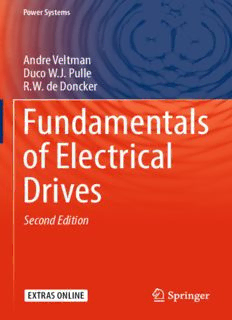
Fundamentals of Electrical Drives PDF
Preview Fundamentals of Electrical Drives
Power Systems Andre Veltman Duco W.J. Pulle R.W. de Doncker Fundamentals of Electrical Drives Second Edition Power Systems AndréVeltman,DucoW.J.Pulle,RikW.DeDoncker FundamentalsofElectricalDrives Moreinformationaboutthisseriesathttp://www.springer.com/series/4622 André Veltman (cid:129) Duco W.J. Pulle R.W. De Doncker Fundamentals of Electrical Drives Second Edition 123 AndréVeltman DucoW.J.Pulle TUEindhoven EMSynergy PiakElectronicDesign Milperra,NSW Culemborg,Gelderland Australia TheNetherlands R.W.DeDoncker RWTHAachenFB FB6Elektrotechnik Aachen,Germany ISSN1612-1287 ISSN1860-4676 (electronic) PowerSystems ISBN978-3-319-29408-7 ISBN978-3-319-29409-4 (eBook) DOI10.1007/978-3-319-29409-4 LibraryofCongressControlNumber:2016931895 ©SpringerInternationalPublishingSwitzerland2007,2016 Thisworkissubjecttocopyright.AllrightsarereservedbythePublisher,whetherthewholeorpartof thematerialisconcerned,specificallytherightsoftranslation,reprinting,reuseofillustrations,recitation, broadcasting,reproductiononmicrofilmsorinanyotherphysicalway,andtransmissionorinformation storageandretrieval,electronicadaptation,computersoftware,orbysimilarordissimilarmethodology nowknownorhereafterdeveloped. Theuseofgeneraldescriptivenames,registerednames,trademarks,servicemarks,etc.inthispublication doesnotimply,evenintheabsenceofaspecificstatement,thatsuchnamesareexemptfromtherelevant protectivelawsandregulationsandthereforefreeforgeneraluse. Thepublisher,theauthorsandtheeditorsaresafetoassumethattheadviceandinformationinthisbook arebelievedtobetrueandaccurateatthedateofpublication.Neitherthepublishernortheauthorsor theeditorsgiveawarranty,expressorimplied,withrespecttothematerialcontainedhereinorforany errorsoromissionsthatmayhavebeenmade. Printedonacid-freepaper ThisSpringerimprintispublishedbySpringerNature TheregisteredcompanyisSpringerInternationalPublishingAGSwitzerland Thisbookisdedicatedto ourfamiliesand friends Foreword Within one academic lifetime, the electric drive has progressed from the three- machine DC drive called the Ward-Leonard system to today’s sophisticated AC drives utilizing PWM inverter power electronics and field orientation or direct torquecontrol.Roughlyaroundthe same period,machinetheory progressedfrom the classical “one machine at a time” approach to the generalized or unified approachemphasizingsimilaritiesbetweenmachinetypes.Thisunifiedtheoryalso utilized much more sophisticated mathematical tools to obtain models applicable to transients as well as steady state. This enabled theoretical modeling a host of important machine problems, but almost always required computer solutions as opposed to more general analytic solutions. This often left one with a feeling of detachmentfromthephysicalrealityofinrushcurrents,thewhineofspinningrotors, andthesmellofover-warmelectricalinsulation. Partway through my academic lifetime, I was introduced to the next phase of unifiedtheory;theuseofcomplexnotationtomodeltheeffectivespatialorientation of quantities within a machine. This concept, often called space vector theory, providesa much clearer mathematicalpicture of what is happeningin a machine, butattheexpenseofanotherlevelofabstractioninthemodel.However,theinsights providedto oneinitiated in the methodare so significantthattodayessentially all workindrivecontrolispresentedinthisformat.Andthereinliesaproblem.Tothe uninitiatedthesepresentationsappearquiteunintelligible,andaroutetobecoming initiatedisgenerallyhardtofindandoftenhardertofollowoncefound. This purpose of this book is to show the theory and notation used, in modern electric drive analysis and design at an introductory level. The authors, bring an exceptionalbreadthofknowledgetothisbookmakingitstandoutfromotherbooks thatonlyprovidingmathematicalfoundationforadvancedwork.Thisstrongeffort ismadetopresentthephysicalbasisforallofthemajorstepsindevelopment,andto givethespacevectorphysicalandmathematicalmeaning.Readersusingthebook forself-studywillfindthesetsofsimulationtutorialsattheendofeachchapterof specialvaluein masteringtheimplicationsandfinepointsof thematerialcovered inthechapter. vii viii Foreword Electric machine theory with its interacting temporal, spatial variations and multi-windingtopologiescanappeartobeaverycomplicatedanddifficultsubject. The approach followed in this book is, I believe, one that will help eliminate this perceptionbyprovidingafundamental,coherent,anduser-friendlyintroductionto electricmachinesforthosebeginningaseriousstudyofelectricdrivesystems. Madison,WI,USA DonaldW.Novotny Preface Our motivationandpurposeforwriting thisbookstems fromourbeliefthat there isapracticalneedforalearningplatformwhichwillallowthemotivatedreaderto gainabasicunderstandingofthemodernmultidisciplinaryprincipleswhichgovern electrical drives. The book in question should appeal to those readers who have anelementaryunderstandingofelectricalcircuitsandmagneticsandwhohavean interestorneedtocomprehendadvancedtextbooksinthefieldofelectricaldrives. Considerationhasalso beengivento thoseinterestedinusingthisbookas a basis forteachingthissubjectmatter.Inthiscontext,aSpringerwebsiteExtraMaterials hasbeensetupwhichcontainsthe simulationexamplesandtutorialsdiscussedin this book. Furthermore, all the figures in this book are available on the Springer website,inordertoassistlecturerswiththepreparationofelectronic“powerpoint” typelectures. Electrical drives consist of a number of components: the electrical machine, converter,andcontroller,allofwhicharediscussedatvariouslevels.Abriefrésumé of magnetic and electrical circuit principles is given in Chap. 1 together with a set of generic building modules which are used throughoutthis book to represent dynamicmodels.Chapter2isdesignedtofamiliarizethereaderwiththeprocessof buildingadynamicmodelofacoilwiththeaidofgenericmodules.Thispartofthe text containsan introductionon phasorsas requiredfor steady-state analysis. The approach taken in this and the following chapters is to present a physical model, which is then represented by a symbolic model with the relevant equation set. A generic modelis then presentedwhich formsthe basis for a set of build and play simulationssetoutinvariousstepsinthetutorialattheendofthechapter. Chapter 3 introduces a single-phase ideal transformer (ITF) which forms the basisof a generictransformermodelwith leakageand magnetizinginductance.A phasoranalysisis givento familiarizethe readerwith the steady-state model.The buildandplaytutorialsattheendofthechaptergivethereadertheopportunityto buildandanalyzethetransformermodelundervaryingconditions.Itisemphasized that the use of these build and play sets are essential componentsof the learning processthroughoutthisbook. ix
Description: